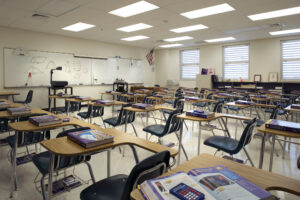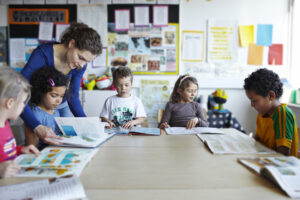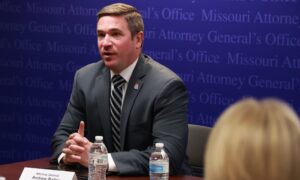9:20
News Story
Raytown students wanted crackdown on violence, guns in school. Making the right changes is tricky
In early February, Raytown High School sophomore Harper York crossed the street to pick up some M&Ms from a Casey’s store before her next rehearsal.
Suddenly, she turned around from the checkout and saw a “mob fight” had broken out.
When the chaos died down and she got over her initial shock, Harper made a break for it.
“I don’t think I’ve ever run so fast across the parking lot in my life,” she said. “And before I cross the street, I look back and another (fight) is starting. … I can hear police sirens and ambulances, and people are on the ground, and people are crying. And it’s just like: Is this who we are?”
While the gas station fight was the biggest Harper had seen, physical altercations in or near school had become common.
Even bystanders weren’t safe. A few days later, junior Chase Dernier ended up near a fight that turned into a large-scale shoving match. He got slammed into a wall, hitting his head hard enough to make it ache for days.
“A lot of us, we were scared to go to school. We were scared to leave our class to go to the next class,” Chase said. “We thought we were going to get caught up in a mob fight.”
The last straw came when school officials confiscated three firearms from students in a two-week period.
Chase and Harper recruited classmates and other district residents to call leadership, attend the February school board meeting and sign up for public comment. They pushed for changes such as longer suspensions for students who fight and adding metal detectors to school.
Since that public pressure, students say Raytown High School has made effective changes, such as hall sweeps targeting students who aren’t in class. They’ve also seen signs that the district is seriously considering other measures such as installing weapons detectors.
Superintendent Penelope Martin-Knox said fully solving the problems of frequent fights and guns entering school requires combing through all the ideas to find what will actually work.
Schools throughout the country have been grappling with the ways traditional discipline and security tactics can cause long-term harm to students who make mistakes, exacerbate racial disparities and make school feel a little like jail.
Martin-Knox has also watched other districts seize on solutions that fail, such as when weapons make it past metal detectors.
“I don’t want to give people a false sense of hope,” she said. “I just need to make sure that what we do is going to be as effective as it possibly can be.”
What’s happening at Raytown High School
Reiko Groves first appeared in front of the school board to perform a song from Raytown High School’s spring musical, “Six,” which reimagines Henry VIII’s wives as pop icons.
Reiko wishes she could have focused on her performance alone.
Instead, still in costume, the high school junior returned to the front of the audience and addressed the board as herself: a teenager worried about guns and violence.
“I go from performing for this great show that I was so proud of, to now I have to go speak about how, even though I love the (school) building, I don’t feel safe in it,” she said later. “I have to go fight for … almost my ability to perform (and) make sure everybody’s safe while performing.”
After students’ basic physical safety is secure, Reiko said, “we can focus on the well-being of our students to find solutions to not only survive, but thrive in Raytown schools.”
Students say the school climate hasn’t always been like this. But during the fall semester, violence started to feel like an everyday thing.
Incidents reached a peak in December, according to district data reported to the board. Students were in school for less than three weeks that month. But during that time, there were 50 suspensions for fighting and school officials confiscated three firearms.
Harper said she started begging her parents to let her stay home from school, even though it meant she would miss beloved activities like theater rehearsals. Chase, normally proud of his high attendance, was skipping school to lie in bed, feeling “mentally drained.”
They weren’t aware of the firearms found in December until later, but they did hear about three additional guns found during a two-week period in late January and early February.
The weapons weren’t fired or brandished, Martin-Knox said. School officials found them by searching students after suspicions were raised: a bullet found on a hallway floor, a phone call about a social media post.
The students said they weren’t planning to use the guns at school, Martin-Knox said.
“I heard the reasonings of, ‘You don’t know where I have to walk when I go home. You don’t know what happens when I get off the bus. I have to go to a relative’s house in a different community somewhere. And I just need to safeguard myself,’” she said.
But bringing a gun to school is a “nonnegotiable” that comes with legal consequences and the student’s permanent removal from in-person school, Martin-Knox said.
Consequences for fights can vary, but some students have argued they should be harsher.
“They think they’re trying to help the students,” Chase said. “But in reality, by lowering the suspension rates, it’s not holding students accountable.”
A rumor that suspensions for fighting have been uniformly reduced to three days from nine days isn’t true, Martin-Knox said. But she has emphasized to principals that they have discretion to set suspension lengths based on the circumstances.
In recent years, some schools have made a concerted effort to reduce discipline tactics that can harm students’ education or life prospects, such as removing them from school or involving law enforcement. That’s especially in light of evidence that they can disproportionately target students of color and those with disabilities.
Martin-Knox said schools also need to figure out how to help students understand and take responsibility for their actions when they return from suspension.
“Because otherwise,” she said, “I’m going to send you back out there, (and) you’re going to do it again.”
High tech vs. low tech solutions
Schools nationwide are seeing more verbal and physical aggression from students since the return to in-person school after the pandemic, said Kenneth Trump, a school safety consultant.
Administrators face pressure to solve those issues, he said, especially when there are high-profile incidents involving weapons.
“It puts school leaders at great risk of what I call ‘do something, do anything, do it now and do it fast’ type of policy and practice rather than having a comprehensive assessment done of their safety,” he said. “We’re seeing many cases where that includes turning to physical security measures, security hardware products and technology.”
Those solutions don’t always work as promised, Trump said, especially when they aren’t executed perfectly.
Locally, Kansas City Public Schools faced a lawsuit when a knife used in a fatal stabbing made it through a metal detector.
“Your high school coach and a teacher’s aide and the principal working the screening at the front doors, (who) probably got an hour of training, total, on a new product they spent millions of dollars for in your district, is not going to be comparable to the TSA,” he said.
And when those staff members are pulled from other areas of the school, they lose opportunities to interact, head off conflicts before they escalate and build relationships with students who might be willing to tell a trusted adult about a weapons plot.
“One of the best, strongest security measures in a school is a visible, actively supervising adult,” he said.
That has borne out at Raytown High School, according to several students who credited a reduction in fights to regular hall sweeps — where students late to class are locked out, rounded up and warned or disciplined — and increased patrolling by security staff and administrators.
Some of the security measures can be double-edged swords.
Reiko says she understands why the school no longer holds assemblies — they were leading to fights — but is sad to miss out on the experiences.
The hallway sweeps can be anxiety-inducing, and she’s been stopped and questioned more often while on legitimate errands for her classes.
But she also appreciates the reduction in fights and being able to go to the bathroom without finding all the stalls filled by students skipping class.
“Probably the hardest part about this is finding that balance between … making sure it is truly a safe environment, but also not making it feel like it’s a prison or giving punishment that’s too harsh,” she said.
Weapons detection
Students said they’d appreciate weapons detectors in schools despite potential drawbacks, such as feeding into racist stereotypes and perceptions that the school is dangerous.
“As a Black student in the school district, I care more about our Black bodies than our reputation in the schools in the surrounding area,” Reiko told the board. “And being brutally honest, ‘they’ will think we are ghetto no matter what we do.”
Martin-Knox isn’t ruling out metal detectors in schools, but she says she needs to think through what schools would need to make them work, such as locking and putting sensors on additional doors and windows.
“I’m not going to invest district money, taxpayer money, or even grant money on something just to say I’ve done it,” she said.
The district has already begun increasing security measures for sporting events, which can bring large numbers of unknown people onto school grounds, Martin-Knox said.
At its March meeting, the board approved purchase of a weapons detection system that it hopes will streamline the security scans, spending $300,000 in Department of Elementary and Secondary Education safety grant funding and more than $22,000 in other district funds.
The system can be set to target dense metal shapes that might be a firearm, said Josh Hustad, director of facility operations, allowing people to pass through more quickly without taking small items out of their pockets and bags.
Raytown has spoken with other districts who have used the system, such as Wichita, to learn how it works and what pitfalls to expect, Hustad said.
For example, they’ve heard a laptop, a folded umbrella, or “two Red Bull cans side by side” could set it off, he said.
The three students who spoke with The Beacon said they were invited to join a student committee on school safety and participated in a test of the detectors at the school entrance.
Chase and Harper appreciated that they were unobtrusive and only required them to remove laptops from bags.
Chase said students speculate that moving the portable detectors from sports games to school entrances could be an easy next step once the devices are in schools’ possession.
Next steps at Raytown High School
After major incidents, Martin-Knox said she always visits the affected school, talks to students and works on refining safety plans.
In addition to the student committee, the district recently launched a school safety task force that will make recommendations.
Chase hopes for more safety measures such as clear backpacks — which he’s heard are on backorder but will arrive next year — and weapons detectors in schools, he said.
In general, he feels seen, heard and supported by Martin-Knox and Raytown High School’s principal and assistant principals, but would like to see school board members take action on policy and spend more time in schools.
Students also wish they hadn’t had to speak out before they started seeing concrete changes.
“They obviously want us to be safe,” Chase said of leadership. “I think they could have done things in a more proactive manner. But that change is happening now.”
This article first appeared on The Beacon and is republished here under a Creative Commons license.![]()
Our stories may be republished online or in print under Creative Commons license CC BY-NC-ND 4.0. We ask that you edit only for style or to shorten, provide proper attribution and link to our website. AP and Getty images may not be republished. Please see our republishing guidelines for use of any other photos and graphics.





